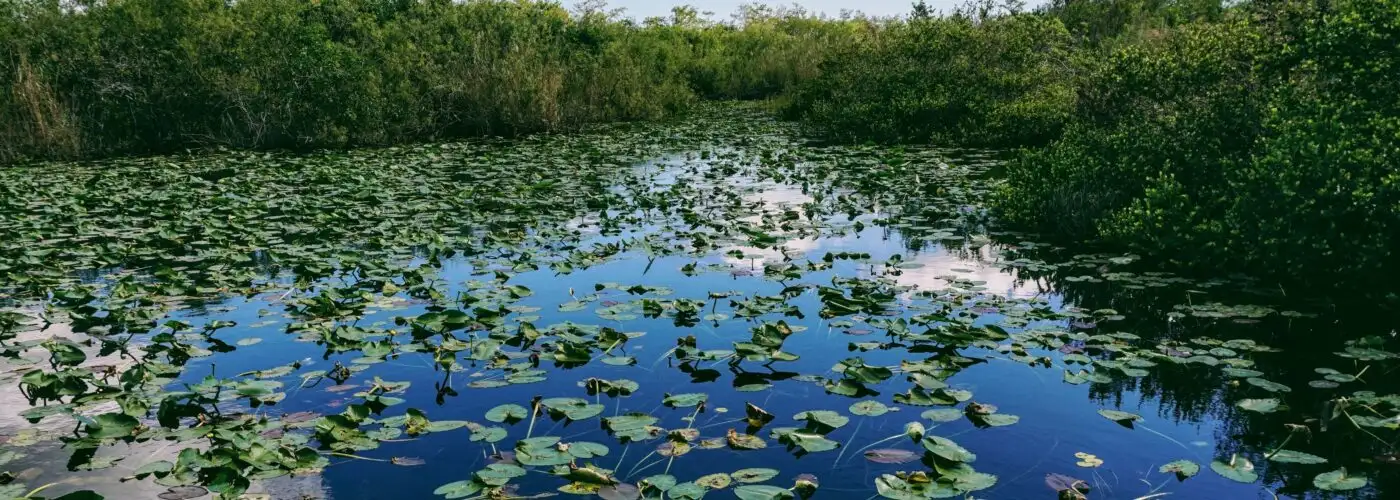We’re kicking things off in Florida’s Everglades. Here’s why you should go right now:
Why Everglades National Park Is Amazing
Spanning 1.5 million acres of southern Florida, Everglades is the third-largest national park in the continental United States (behind Death Valley and Yellowstone, respectively), protecting what is left of a crucial wetlands that was once nearly four times its current size but has been lost to development. This so-called “River of Grass” is also a UNESCO World Heritage Site, an International Biosphere Reserve, and a Wetland of International Importance (one of just three areas in the world holding all three distinctions) and is home to more than 70 endangered and threatened species, including the Florida panther, a number of sea turtle species, and manatees—and is the only place in the world where alligators and crocodiles co-exist.
There are five visitors centers (open every day) that serve as points of entry; because the park is so large, it’s best to plan your route through the park based on what you’d like to see or do, whether it’s sightseeing by car, bike, hiking or boat. Although there are many gateway towns with hotels, there are no accommodations in the park other than car campgrounds and back-country camping spots (permits required). Or for a real adventure, you can paddle a canoe or kayak to spend the night on a chickee, a wooden platform built above the swamp.
Why January Is the Perfect Time to Go
There are two seasons in the Everglades, wet and dry. The dry season runs from December through about mid-May and is the most popular season for good reason: The temperatures are mild (typically in the 70s, though colder spells are common), the humidity is low, and the biting bugs are blessedly absent. This is prime bird-watching time, as species from all over the U.S. and beyond migrate here to overwinter, nest, and raise their young. Wildlife viewing is also at its best— the water dries up significantly, so the deer, wading birds, alligators, turtles, and other animals tend to concentrate around the permanent sloughs.
Why It’s Great Other Time of Year
There’s no way around it: The wet season can be brutal in the Everglades, with frequent, violent thunderstorms, oppressive humidity, and vast clouds of mosquitoes and biting flies. But if you’re well prepared (good rain gear and the best bug spray money can buy), you’ll be able to experience a kind of solitude in the Everglades that very few ever will.
If You Go, Don’t Miss
From October through April, there are a wealth of ranger-led tours, including a Full Moon Bike Ride along the 15-mile Shark Valley Loop in the northern part of the park, about 40 miles west of Miami. As the sun sets and the moon rises, herons, cormorants, and other feathered denizens will strike up a birdsong symphony while you pedal to the observation tower overlooking the Sawgrass River. The three-hour ride is popular and fills up quickly, and reservations are required (by calling 305-221-8776). You must bring your own bike. (Can’t get reservations? You can still do the ride yourself. The park never closes but the parking lot closes at 6 pm, so just leave your car outside the park and ride in on your bike.)
January Bonus Pick: Saguaro National Park
Winter is a reliably good season for exploring Saguaro National Park just outside Tucson, Arizona, where you’ll gaze at rolling “forests” of its namesake cactus—found only in the Sonoran Desert. This stately icon of the American West can take 75 years to grow its first “arm,” but it eventually reaches up to 50 feet high and lives 200 years, or even longer. Saguaro National Park is actually two parks in one, divided into east and west districts about 30 miles apart on either side of Tucson. Consider visiting both districts; in addition to the stunning cactus-studded landscape, the western Tucson Mountain District is home to petroglyphs dating back thousands of years, many of which you can see along the Signal Hill Trail. And in the eastern Rincon Mountain district, sky islands (mountains emerging from the desert floor) are home to such beloved desert animals as bobcats, mountain lions, black bears, and coati.
Editor’s note: This story was originally published in 2016. It has been updated to reflect the most current information.
More from SmarterTravel:
- The Best National Parks in the U.S., as Recommended by Park Rangers
- 12 Gorgeous Photos of America’s National Parks
- The 10 Best National Parks to Visit in Winter
Deb Hopewell is a longtime journalist and the former editor of Yahoo Travel. She writes for Outside, Fodor’s, Architectural Digest, Travel+Leisure, Yahoo Travel, and others. Follow her on Instagram @debhopewell and Twitter @dhopewell.
We hand-pick everything we recommend and select items through testing and reviews. Some products are sent to us free of charge with no incentive to offer a favorable review. We offer our unbiased opinions and do not accept compensation to review products. All items are in stock and prices are accurate at the time of publication. If you buy something through our links, we may earn a commission.
Related
Top Fares From
Today's Top Travel Deals
Brought to you by ShermansTravel
Kenya: 14-Night Tour, Incl. Tanzania &...
smarTours
 vacation
$7125+
vacation
$7125+
7-Night Caribbean Round-Trip Cruise From Orlando:...
Norwegian Cruise Line
 cruise
$739+
cruise
$739+
Ohio: Daily Car Rentals from Cincinnati
85OFF.com
 Car Rental
$19+
Car Rental
$19+




